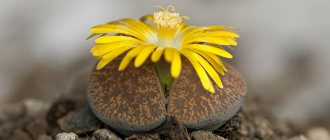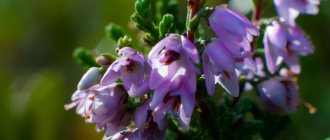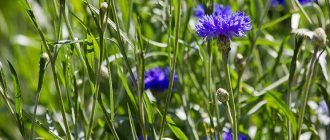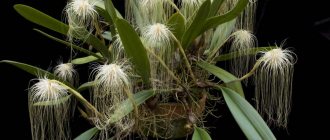When you first look at a living stone flower, you get the impression that it is artificial. The reason for the misconception is the structure of the plant: the flowers seem to grow directly from thick, porous stones. However, those who have come across lithops (Lithops) or have them in their home flower garden know that the apparent stones are quite living petals that require special care. Like most succulents, the plant requires proper watering, good lighting and a cool winter. About this and other features of growing home lithops in the following material.
Briefly about care
- Watering. During the hot period, once every two weeks, and in winter it is not watered. Water should only fall on the soil.
- Illumination. Loves the sun, but should be shaded during the growth period. In winter, additional lamp light is needed.
- Air humidity. Tolerates dry and humid air well. Avoid drafts, but ventilate the room where the flowerpot is located.
- Temperature conditions. Summer and spring: +22–+25С. In winter - not lower than +10 C.
- Bloom. Blooms in autumn at the age of 3–5 years. Flowers can be observed for about two weeks.
- Rest period. It begins after the end of flowering (late autumn) and lasts until the beginning of spring. Requirements: humidity 50%, artificial lighting.
- Transfer. The purchased flower is immediately transplanted into prepared light soil. Adult lithops are transplanted every 2–4 years.
- Soil mixture. Loose, with the addition of sand, small pebbles, broken bricks. A mandatory requirement for soil for growing lithops is neutral acidity. Otherwise, the succulent will not live long.
- Fertilizers. Generally recognized “survivalists” do not need feeding. The exception is for specimens that have been sitting in the same pot for over 5 years. From spring to autumn, once every 4 weeks, fertilize the lithops with fertilizers for cacti (divide the dose from the instructions by 2).
- Reproduction. Lithops do not propagate like most houseplants, but are grown from seeds.
- Diseases. Excess moisture causes root rot, new leaves form before the old ones dry out, swell, and become covered with rusty spots. With insufficient lighting, the patterns on the upper parts of the leaves turn pale and the leaves begin to stretch.
- Harmful insects. Mealybugs, rootbugs, sciarids (fungus gnats), spider mites. Pests usually come from nearby house flowers.
Reproduction of Lithops
“Living stones” reproduce by seeds and vegetatively. Older lithops, under favorable conditions, produce two pairs of new leaves, but rarely. This is one plant with a common root, so it is difficult to plant a sprout. Lithops is easier to propagate by sowing, this is exactly what happens in nature. Seeds can be purchased at flower shops.
Before sowing, the seeds are not soaked, but are immediately distributed on the surface of a damp substrate and lightly pressed against it. The temperature favorable for germination is from 18 to 20°C. Cover the top with cling film. After 1–3 weeks, shoots will appear. After about a year, the seedlings are transplanted into separate pots.
Description of the plant
The natural habitat of Lithops (family Aisaceae, Aisoaceae) is the rocky South African desert or the Southwestern part of the African continent. Especially many species grow in South Africa, Namibia, Botswana, and Chile.
“Living stones” grow well on rocky slopes, sandy, and aluminous areas. Plants quickly adapt to their environment and can even change color. Blending in color with the surrounding landscape, hiding among the stones from the sweltering heat, lithops survive where another flower would not last even a day (in the plant’s homeland, daytime heat of fifty degrees is replaced by extremely cold nights).
Historical fact! The plant was discovered and named by the British botanist naturalist D. W. Burchel, who discovered stone-like leaves at the Cape of Good Hope. Only after the publication of his Geographical Catalog in 1815 did they learn about lithops in Europe.
The name “lithops” itself is derived from two Greek words lithos + opsis, meaning “stone” and “similar”. The literal sound is like a stone. This is where the common name “living stones” comes from.
Looking at the flower, you will immediately understand why the Greeks used these exact words: in appearance, lithops resemble small flat stones. And they grow extremely slowly - another reason to compare succulents to stone.
It is believed that this appearance was formed by environmental conditions. Disguising itself as a common stone background, the plant hid from grazing herbivores. Only during the flowering period, when a bright flower appears, does the succulent become vulnerable.
Types of flowers and their photos
In nature, there are more than thirty species of this succulent . They differ in size, color and shape of leaves, depth of the gap, shades and sizes of flowers. Here are a few of the most common ones.
Beautiful (Bella)
It consists of several pairs of identical leaves with a diameter of up to 2.5 cm and a height of 3 cm. The leaves of this species are yellow-brown in color. It blooms with white flowers, up to 3 cm in diameter, emitting a light aroma.
Salicola
Grows in several pairs. The height and width of the plant are 2-2.5 cm. The crack between the leaves is shallow . The leaves are olive green with dark green streaks and a flat surface. It blooms with small white flowers that appear from the crevice between the leaves.
Divergens
It grows in a group of several pairs of leaves, which can vary in size and height (from 1 to 3 cm). The crack between the leaves is deep. The leaves are green with gray-green spots, the surface of the leaves is beveled. The flowers are yellow in color, up to 5 cm in diameter.
Leslie
Grows up to 5 cm in height. Its leaves are gray with light brown spots scattered throughout. It blooms with large yellow flowers that can completely hide the plant itself. After the flower withers, young leaves appear in the place from which it grew .
False truncated (Pseudotruncatella)
It has gray, pinkish or brown leaves separated by a shallow slit. On the flat surface of the leaves you can see a dotted or linear pattern of a darker shade. It blooms with bright yellow buds with a golden hue.
Important : Toxic substances accumulate in the leaves of lithops, so the succulent should be kept away from small children.
You can read more about the types of lithops in this article.
Popular varieties
In the wild, lithops are represented in more than 40 varieties (and it is quite possible that over time there will be even more of them). Only 10 species names are suitable for cultivation under artificial conditions. Especially often grown in home flower beds:
Leslie
Baby lithops (Lithops lesliei) with the aerial part spread out only 20 millimeters. Leslie leaves come in different colors: pinkish-chocolate, cocoa, ocher-greenish, gray and steel shades. Each individual specimen has a unique star pattern on its leaves. The first flowers appear already in the third autumn after the seeds germinate. The lush yellow/white flower appears for just a few days. The aroma is barely noticeable, very gentle and pleasant.
Lithops Leslie (L. lesliei)
Aucamp
No less in demand than the previous Lithops aucampiae. Leaves of emerald, malachite, brown-rust shades are covered with an ornate pattern of dark lines. In rare cases, specimens are found with a gray or bluish color. Several times a year, large, rich yellow or white and yellow flowers bloom, emitting a barely noticeable aroma. The diameter of the leaves of Lithops aukamp is no more than 3 centimeters. During flowering, the diameter increases due to the flower covering the leaves. The height of the above-ground part is 3–4 cm.
Lithops Aucamp (L. aucampiae)
Marble
Marble Lithops (Lithops marmorata) has zinc-gray, upwardly expanded leaves with a 2-centimeter diameter and decorated with a marble pattern. Hence the name of the variety. During the flowering period, a white chamomile-shaped flower with a diameter of 5 cm covers the base of the plant.
Bloom
Lithops are interesting plants that come from the genus of succulents and belong to the Aizov family. They do not have a stem and in appearance resemble small stones, round in shape and of various colors.
Succulents have fleshy, thick leaves that are paired together and separated by a deep hollow. The maximum height can reach up to 10 cm.
When does lithops bloom at home? The plant begins to bloom only in the third year after planting , from late summer to November. Only some individuals bloom, and the rest join gradually every year. An inflorescence appears between the leaves, usually yellow or white flowers. And the bud opens for several hours a day and can cover the entire succulent. The flowers have a large number of sepals and petals.
The buds last 7–12 days. In the case of pollination, a seed box appears at the end of flowering.
Important! Lithops require rest for normal functioning. During hibernation, the process of molting occurs - the replacement of old leaves with new ones. At this time, it is necessary to completely stop watering and place the pot with the plant in a cool, bright place and leave it alone.
The optimal temperature is considered to be 12–16 degrees. Shedding stops in March–April. Only mature succulents require this care. Young seedlings up to a year old need constant watering and additional lighting.
Recommendations from experienced flower growers
With proper care, growing lithops at home is not difficult. Just create the right conditions for the plants and very soon they will thank you with luxurious flowering.
The plant requires rare or moderate watering, using a small child's syringe: during the growing season, watering is carried out twice a month (the first watering is carried out when the old leaves are dry to the skin). From October to December - once a month; in winter, soil moisture is prohibited.
Attention! The water is not hard, settled. Make sure that drops do not fall on the surface of the plant or into the crack.
Most varieties require bright, indirect light (only some grow well in partial shade). Ideal location: south or southeast windows. In winter, the plant is illuminated with lamps: adults at a distance of 10 cm, seedlings - 5–7 cm. In spring, during the period of growth of new leaves, hide the succulent from direct sunlight, reducing the shading time every day.
The plant adapts to any humidity and easily tolerates dry air. Dry, but not stale. Ventilate the room regularly so that the plant is not exposed to a sharp, cold draft.
In summer and spring: +22+25 C. During the wintering period +12+15 C, lithops requires coolness.
Attention! Lowering the temperature to +8 degrees can lead to the death of the flower.
First flowering at 3–5 years. The flowers are chamomile-like in yellow shades of varying intensities, white, crimson, etc. The buds that bloom at noon close by night. Flowering lasts about two weeks, from early August to late October.
Attention! If a three-year-old succulent has not bloomed, reconsider its growing conditions. Most likely, the violation is caused by improper watering, excessive feeding, insufficient lighting, etc.
Biological features of Lithops
The name of the botanical genus Lithops from the family Aizoaceae is a compound word meaning “stone” and “appearance” in Greek. Lithops are native to rocky semi-deserts and deserts, dry grasslands in southern Africa (Namibia, Botswana and South Africa). The unique succulents in the photo look like multi-colored pebbles, small pieces of granite, marble or clay.
Lithops are hardy plants:
- thrive on infertile soil;
- Can withstand direct sunlight during the day;
- ideally adapt to arid climates;
- the small leaf surface evaporates little water.
Mimicry, or camouflage as surrounding rocks, helps lithops to avoid being eaten by herbivores. In addition, substances toxic to animals accumulate in leaf tissues. During the day, “living stones” endure the drying heat (the temperature on the soil surface reaches 50°C), and withstand the cold at night.
Plant structure
Under natural conditions, only the upper part of the lithops is visible among the stones and sand, which helps reduce evaporation. The plant skillfully adapts to its environment. “Living stones” on calcareous soils acquire gray-green shades, on ferruginous substrates - red-brown shades.
How are lithops arranged?
- The taproot, which is relatively long for succulents, draws water from deep in the soil.
- The shoot consists of a shortened underground stem and two fused thick leaves, which are usually separated in the middle by a slit.
- The shape of the above-ground part is spherical or cylindrical, flat or rounded at the top, and cone-shaped at the bottom.
- Mature leaves reach a height of 3–5 cm.
- The surface is monochrome or patterned.
The transparent area on the surface of the lithops is a leaf “window” that lets in the light necessary for photosynthesis. The sides are covered with green fabric on the inside, and have a grey-green, purple, violet or brown tint on the outside.
Lithops bloom when a new pair of leaves matures. The white, yellow or reddish flowers have a sweet aroma. The buds open at noon or in the afternoon. Flowering usually occurs in August–November, sometimes earlier (until the end of July) or later (at the end of December).
Phases of development of “living stones”
Winter in southern Africa lasts from May–June to August–September. Summer is the period from November to March. The rains begin in October and continue intermittently until March. Precipitation may also occur in winter. Lithops, like many other plants, adapt to the climate. Amazing adaptation manifests itself in the form of a change in three phases of development throughout the year.
Lithops development cycle in temperate climates
| Phase (period) | Duration | Features of development and care |
| Rest period | From October-November or from the end of December to March (May). | The phase begins after flowering. Plants stop growing and use the moisture reserves accumulated in the leaves to maintain life. At room temperature they require minimal watering. Completely dry content - if the temperature is 8–12°C. |
| Growing new leaves | From March to mid-August. | In adult lithops, a new pair of leaflets appears in the gap. At the beginning of the growth phase, there is no need to water, as the plant uses the water and nutrients available in the old leaves. From the end of May, water moderately. |
| Flowering and fruiting | From mid-August–October to November–December. | Young leaves increase in volume. The old leaves are replaced by a new pair and dry out. Lithops flowers and bears fruit. During this period, regular watering is required, but without waterlogging the substrate. |
Depending on the species and conditions of detention in the winter months, the phases of development may shift in time.
Replanting correctly
A transplant is needed if you have just bought “living stones” or your long-lived Lithops has become cramped in an old pot.
A suitable size pot and soil mixture must be prepared in advance. Please note that the Lithops root system goes deep and should not curl. And this will certainly happen if the container is not deep enough. Therefore, to replant a succulent, choose not a wide pot, but a narrow pot with high walls.
Lithops root
Place drainage from crushed bricks, etc. on the bottom. Place soil on top consisting of: leaf/turf soil and millimeter-sized gravel chips (1:1). If you prefer to use a ready-made cactus mixture, add some gravel chips. Heat the soil mixture in the oven for half an hour. This is necessary for disinfection.
To make it easier for the roots to clear the old soil, water the succulent right before replanting. Where the soil mixture has stuck, carefully “walk” with a wooden toothpick.
Having straightened the root along its entire length (without bending or twisting), immerse it in the pot. Add soil little by little, do not press down. The root collar is above ground level. Place small pebbles on top (up to 5 mm in diameter). This will give the plant additional stability and increase soil permeability when watering.
Attention! Do not water lithops for several days after planting!
Few people know that the plants offered for sale are planted in a nutritious, but practically waterproof, airtight peat mixture. In such an environment, living stones do not live long, so do not delay replanting.
Tip: Plant Lithops with other succulents that don't require frequent watering. Place the plants in the same pot at a distance of 2 cm from each other and make sure that it is not only beautiful, but also convenient.
Succulent care
For favorable growth of lithops there are a number of requirements:
- rocky soil that drains water well;
- a lot of sun;
- rare watering;
- regular ventilation.
The sunny side is best for lithops. Having installed the plant on a southern windowsill, you should not turn the pot and move it from place to place, since the succulent does not like frequent changes of place.
Given the powerful root system of Lithops, the pot for it should be medium in size. It is advisable to plant the plant in several pairs in one container, because it does not like loneliness .
The soil should be rocky and easily permeable to air and water. Clay, brick chips, river sand and a little leaf humus must be present. It is useful to place colored pebbles on the surface of the soil around the flower.
In summer it is useful to take the succulent out into the open air, and in winter to create a cool atmosphere for it . Water the plant rarely to prevent rotting of the roots. It is safest to water in a tray so that moisture does not get into the gap between the leaves. When the lithops is at rest (before flowering and after), it cannot be watered at all.
Read more details about caring for lithops in this article.
Possible problems
It happens that inexperienced gardeners complain about the problem of a succulent. Meanwhile, if you properly care for the plant, problems can be avoided. Let's look at the most common violations and their causes:
- new leaves are smaller than the previous ones - a failure in the process of changing old leaves;
- the leaves are wrinkled - not enough watering during the dormant period, or an attack by spider mites;
- the roots began to rot - the consequences of being in a wet peat soil mixture;
- the leaves have swollen and begun to burst - the succulent is over-watered;
- “rusty” spots on the sheets – improper watering;
- patterns on the leaves turn pale - lack of sun;
- does not bloom - too much fertilizer or improper conditions for keeping lithops during wintering;
- Shoots do not appear when propagated by seeds - the seeds are waterlogged or planted too deeply;
- the seedlings are stretched out - there is not enough light;
- green deposits on the soil - waterlogging, inadequate drainage.
If you do not water your lithops correctly, your plant may be attacked by wet rot. The plant begins to wither before our eyes, the leaves lose their elasticity, become thinner, and emit a sharp, repulsive odor. The rotting cannot be stopped. The only thing you can do is remove the affected areas with a perfectly sharpened knife, buy a new pot, and replace the soil mixture.
Before buying lithops, study the description of the species, look at the photo and choose the most suitable plant. You might be interested in the idea of creating a lithops mix by placing several varieties in one succulent garden. This is not only beautiful, but also convenient, because regardless of the variety, living stones are grown the same way.
Diseases and pests
Succulents of this type usually do not get sick, but are susceptible to fungal infection. The infection occurs due to abundant, frequent watering. Often, a plant that begins to rot dies. You need to take the humidification regime seriously and do not overfill it with water.
Fleshy leaves are not to the taste of harmful insects. They rarely attack flowers. In extreme cases, mealyworms settle on them. Pests live not only on the surface of the plant, but also burrow into the soil.
To destroy the worms, it is necessary to remove the lithops from the ground and completely treat it with an insecticide. Then the succulent is dried and placed in a new container with fresh substrate.











